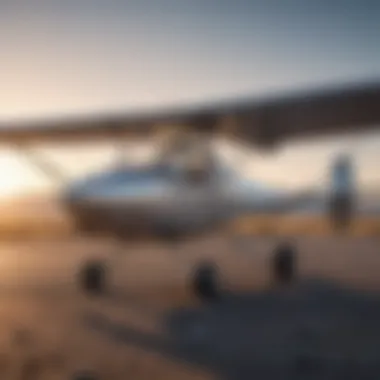Ultralight Aircraft: Design, Benefits, and Future Trends


Intro
Ultralight aircraft have carved out a unique place in the aviation landscape. Defined by their lightweight construction, these aircraft typically weigh less than 254 pounds (115 kilograms) and rely on a simple design. As interest in personal aviation grows, ultralights present an accessible entry point for enthusiasts and professionals alike.
This article aims to delve into the intricate aspects of ultralight aircraft, examining both their advantages and challenges. In doing so, it offers insights into the evolving role these aircraft play in modern aviation practices. Readers will encounter discussions on design principles, regulatory frameworks, and safety considerations — all crucial for anyone considering venturing into this niche of aviation.
Research Background
Overview of the Scientific Problem Addressed
Ultralight aircraft bring with them a myriad of technical challenges and developments. As manufacturers strive to innovate and improve safety features, the need for comprehensive research becomes clear. Unraveling the complexities of flight dynamics, materials science, and regulatory requirements is essential for advancing the field.
Historical Context and Previous Studies
The history of ultralight aircraft dates back to the late 1970s, when advancements in materials and an open regulatory environment fostered their popularity. Past studies have established foundational knowledge, often focusing on specific aspects such as weight optimization and performance characteristics. Researchers have analyzed early models to understand how design affects stability and control. These foundational studies provide a backdrop for current explorations into ultralight aviation’s future.
Findings and Discussion
Key Results of the Research
Recent findings reveal several critical trends in ultralight aircraft development. Innovations in materials, such as advanced composites and lightweight metals, have significantly improved performance metrics. The shift toward electric propulsion systems is also noteworthy, offering cleaner alternatives to traditional fuel.
Interpretation of the Findings
The implications of these findings are profound. The lighter, yet more robust designs offer enhanced fuel efficiency and range, making ultralights more appealing to a broader demographic. Additionally, the integration of technology, such as enhanced avionics, expands the operational capabilities. However, these advancements come with their own set of challenges, particularly in adhering to safety protocols and regulatory compliance.
The landscape of ultralights is shifting, with innovations leading to greater accessibility while demanding new considerations in safety and regulation.
In summary, this exploration of ultralight aircraft accentuates their potential within the aviation industry. The journey ahead involves navigating technical advancements while fostering a culture of safety and compliance.
Prelude to Ultralights
The realm of ultralight aircraft presents a unique intersection of innovation, freedom, and regulatory oversight. This section lays the groundwork for understanding what ultralights are, their significance in the aviation community, and highlights the benefits and considerations surrounding them. By exploring ultralights, we engage with an increasingly popular sector that tantalizes both hobbyists and serious aviators.
Ultralights offer an appealing alternative for those seeking entry into aviation without the weighty financial and technical burdens associated with traditional aircraft.
Definition and Overview
Ultralight aircraft are defined under specific weight and performance parameters, typically under 254 pounds in the United States and adhering to particular design standards. More than just lightweight constructs, ultralights are engineered for simplicity and maneuverability, providing a means of flight accessible to a broader range of individuals. They are not categorized as conventional airplanes; rather, they fall into a category that prioritizes recreational flying over commercial enterprise.
These aircraft often employ minimalistic designs that emphasize ease of use. For instance, many ultralights utilize basic controls like a single stick for maneuvering, making them user-friendly and approachable for novices. The simplified operational framework contrasts sharply with commercial aircraft, where multifunctional controls can overwhelm new pilots.
Historical Context
The development of ultralight aircraft traces back to the late 20th century. The push for recreational flying emerged in the 1970s, paralleling societal shifts toward more personal forms of transport. One of the pivotal moments was the introduction of the ultralight category by the Federal Aviation Administration (FAA) in 1982. This legislation set clear guidelines and opened the skies to a myriad of new aviation enthusiasts.
Since then, the ultralight community has grown substantially, catalyzed by technological advancements such as lightweight materials and improved engine efficiency. The rise of hobbyist builders and clubs has contributed to a vibrant culture centered around education and camaraderie.
Ultralights have faced challenges as well, including safety incidents that prompted discussions about regulatory reform and oversight. Despite setbacks, they continue to thrive, with advancements in design and technology making them safer and more reliable for recreational flying.
In summary, ultralights encapsulate an exciting chapter in aviation history that combines accessibility with innovation. As the enthusiasm for personal flying grows, understanding their role becomes vital for enthusiasts and regulators alike.
Technical Specifications


Technical specifications are vital when examining ultralight aircraft. These specifications govern the operational limits and capability of these aircraft, influencing design choices and usability. Understanding various technical aspects, such as weight and size regulations, engine performance, and design variants, helps ensure safety and compliance with aviation standards. This section will delve into these elements, providing insights that are essential for both aspiring pilots and seasoned enthusiasts.
Weight and Size Regulations
Weight and size restrictions are critical in the classification of ultralight aircraft. In the United States, the Federal Aviation Administration (FAA) defines an ultralight as an aircraft that weighs no more than 254 pounds, without fuel. Additionally, it cannot exceed a maximum fuel capacity of five U.S. gallons. This category permits a maximum stall speed of 24 knots. Meeting these criteria ensures that ultralights remain lightweight, promoting maneuverability and ease of use.
Importance of Weight and Size Regulations:
- Safety: Lighter aircraft tend to perform better in terms of safety. They can take off and land in shorter distances.
- Affordability: Lighter components usually mean lower production costs. This makes ultralights more accessible to a broader audience.
- Simplicity: Smaller planes often require less training for pilots, enabling more people to experience flying.
Engine and Performance Metrics
The engine is a crucial component of ultralight aircraft, as it directly affects performance metrics. Most ultralights utilize lightweight engines, such as the Rotax 582 and the Kawasaki 440. These engines typically range from 40 to 100 horsepower, providing the necessary thrust without adding significant weight.
Key Performance Metrics Include:
- Cruise Speed: Generally, ultralights cruise at speeds between 30 and 55 knots, making them suitable for recreational flying.
- Climb Rate: An adequate climb rate, usually between 200 to 800 feet per minute, ensures effective altitude gain during flight.
- Endurance: The endurance of ultralights varies, but many can operate for upwards of 4 to 6 hours on a full tank depending on fuel capacity.
Design Variants
Ultralight aircraft come in various designs, each tailored for specific uses and pilot preferences. Common design variants include trikes, weight-shift control aircraft, and fixed-wing models. Each design has its unique strengths and weaknesses, appealing to different demographics within the aviation community.
Examples of Design Variants:
- Trike Wings: Lightweight and easy to handle, trikes offer an open-air flying experience and are great for beginners.
- Fixed-Wing Models: These often resemble traditional aircraft and offer stability and higher cruising speeds.
- Powered Paragliders: These provide a unique flying experience, combining gliding with powered flight.
Understanding these distinctions allows potential pilots to make informed decisions based on their flying goals and preferences. As the ultralight market continues to evolve, new designs and technologies will emerge, further enhancing the diversity in this category.
"Technical specifications are not just numbers; they represent the balance between safety, performance, and enjoyment in aviation."
Examining the technical specifications of ultralight aircraft contributes to a deeper understanding of both their capabilities and limitations, thus shaping the future of ultralight aviation.
Advantages of Ultralight Aircraft
Ultralight aircraft present numerous advantages that make them a popular choice among aviation enthusiasts and casual flyers. This section discusses these benefits in detail, focusing on cost-effectiveness, ease of use, and accessibility for new pilots. Understanding these elements is essential for anyone considering the potential of ultralights in the aviation landscape.
Cost-Effectiveness
One of the primary advantages of ultralight aircraft is their cost-effectiveness. These aircraft are generally much less expensive to purchase and maintain compared to traditional light aircraft. The initial investment is lower, making it more feasible for individuals or small businesses to acquire one.
- Lower Purchase Costs: Many ultralights can be acquired for a fraction of the price of conventional airplanes. This reduction in financial commitment is attractive for hobbyists and new aviators.
- Affordable Maintenance: The simpler design and fewer components in ultralights often result in lower maintenance costs.
- Economical Operation: Often, they use less fuel and can operate on a wide range of terrain. This means operational costs are kept at a minimum.
These factors combined make ultralight aircraft a smart choice for those venturing into the world of flying without excessive financial pressures.
Ease of Use
Ultralight aircraft are designed with user-friendliness in mind. This design principle is evident in several aspects, making them easy to fly for both experienced pilots and novices alike.
- Simplified Controls: Most ultralights have straightforward control systems, often similar to those found in gliders or light sport aircraft. This simplicity reduces the learning curve for new pilots.
- Less Regulatory Burden: Since ultralight aircraft typically fall under less restrictive regulations, pilots can often enjoy flying with fewer bureaucratic hurdles.
- Quick Learning Curve: Many new pilots find they can achieve proficient flying skills within a shorter time frame when working with ultralight aircraft.
The ease of use associated with these planes enables more people to experience the joys of flying, making them a significant asset in the realm of personal aviation.
Accessibility for New Pilots


Ultralight aircraft serve as an accessible entry point for new pilots looking to get into aviation. This accessibility is crucial in nurturing interest in flying and expanding the pilot community.
- Lower Training Requirements: Ultrlight operations often require less extensive training compared to heavier aircraft. This not only saves time but also reduces costs involved in pilot education.
- Expanded Locations for Flight: Ultralights can typically be flown in more varied environments than other aircraft, including parks and open fields. This increased flexibility allows for a wider range of flying opportunities.
- Community Support: The ultralight flying community is known for its welcoming nature. Many groups and clubs provide support and resources to newcomers, fostering a spirit of collaboration and mentorship.
Challenges and Limitations
Understanding the challenges and limitations of ultralight aircraft is essential for anyone interested in this field. While ultralights offer unique benefits, they also present certain issues that can impact pilots and enthusiasts. This section delves into key challenges, highlighting their relevance and potential effects on those involved in ultralight aviation.
Safety Concerns
Safety is a paramount issue in aviation, and ultralights are no exception. The lightweight design can lead to increased vulnerability in case of accidents. Notable factors include:
- Structural Integrity: Ultralights are often built with lighter materials, which can compromise strength. Certain models may not withstand severe turbulence or hard landings.
- Pilot Experience: Many ultralight pilots might lack extensive training or flying experience. This can pose a risk, particularly during adverse conditions or emergencies.
- Limited Safety Features: Compared to traditional aircraft, ultralights frequently lack advanced safety features such as parachute systems or redundant controls. Pilots must be aware that their safety relies more on personal skill and decision-making.
"Pilot training and preparation are just as crucial in ultralight aviation as they are in any other flying field."
Regulatory Restrictions
The operation of ultralight aircraft is subject to a specific set of regulations, which vary by country. In the United States, the Federal Aviation Administration defines ultralights under Part 103, presenting both benefits and limitations:
- Weight and Speed Limits: Ultralights must adhere to strict weight and speed thresholds, limiting the potential for certain types of flight maneuvers.
- Pilot Certification: Although ultralight pilots do not need a traditional pilot's license, they must understand pertinent regulations and operational guidelines. In some countries, this can create barriers to entry for new aviators.
- Operational Restrictions: Some areas may restrict ultralight operations due to noise, environmental impact, or airspace classification. Engaging with local authorities is critical to ensure compliance.
Weather Dependency
Ultralight aircraft can be particularly affected by weather conditions. Their lightweight nature and basic design mean they respond dramatically to environmental changes:
- Wind Sensitivity: Ultralights can be more susceptible to gusty winds, making them challenging to fly in certain conditions. Pilots must develop skills to assess and respond to windy situations securely.
- Visibility Issues: Flying at lower altitudes can lead to visibility concerns, especially in fog or haze. Pilots must evaluate weather forecasts continuously.
- Thermals and Updrafts: While some pilots enjoy flying during thermal conditions, ultralights may find updrafts and downdrafts more potent, which requires careful handling and awareness.
For those interested in further exploration of these topics, consult Wikipedia or Britannica for in-depth research.
Regulations Governing Ultralights
Regulations surrounding ultralight aircraft are crucial for maintaining safety, accountability, and overall structural integrity within the aviation sector. Understanding these regulations is essential not only for pilots and manufacturers but also for enthusiasts who wish to explore this niche area of aviation. Regulatory frameworks set the parameters within which ultralight operations occur and ensure that they align with broader aviation safety standards. The benefits of clear regulations include the reduction of accidents, fostering public trust in ultralight operations, and providing guidance for responsible flying. By incorporating regulations that govern ultralight aircraft, practitioners can navigate potential risks while enjoying the unique advantages these machines offer.
FAA Regulations in the United States
In the United States, the Federal Aviation Administration (FAA) governs ultralight aviation through specific regulations that cater to this particular category of aircraft. According to the FAA, ultralight vehicles are defined as having a maximum empty weight of not more than 254 pounds, a maximum fuel capacity of 5 gallons, and a maximum speed at full power of not more than 55 knots. The rules are designed to ensure that ultralight pilots operate under conditions that minimize safety risks.
Here are some essential points to consider regarding FAA regulations for ultralights:
- Pilot Requirements: Pilots do not need a medical certificate or a pilot license, but they must understand the basics of aviation and safety.
- Operational Limitations: Ultralights cannot be used for commercial purposes or fly over congested areas.
- Maintenance Responsibilities: Owners must ensure their aircraft remain in operational condition to meet safety standards.
The regulations also help delineate ultralights from other types of aircraft, simplifying compliance and enhancing safety measures. More importantly, they stabilize the ultralight market by providing structure and reliability to manufacturers and consumers.
International Regulations
Globally, the regulations governing ultralight aircraft vary significantly by country and jurisdiction. This variation is essential due to diverse aviation cultures and operational environments. In many regions, ultralights are often categorized under different names, such as microlights or light sport aircraft.
Key elements of international ultralight regulations include:
- Weight and Performance Standards: Each country has established its own weight limits and performance capabilities for ultralights, akin to the FAA's standards.
- Pilot Licensing: Many countries require pilots to obtain specialized ultralight licenses, or they may have no requirements at all, depending on local regulations.
- Registration: Some nations require ultralights to be registered with aviation authorities, while others do not. This impacts accountability and traceability.
Air regulations bodies, such as the International Civil Aviation Organization (ICAO), are working towards harmonizing some of these rules to facilitate international ultralight operations. As the ultralight community grows, adapting to these changes becomes crucial for ensuring safety and legality.


Emerging Trends in Ultralight Aviation
The world of ultralight aviation is continuously evolving. Developments in technology and shifts in environmental awareness are shaping the future of how these aircraft are designed, built, and used. Understanding these trends is critical for enthusiasts, professionals, and regulators in staying relevant. This section covers the significance of emerging trends, focusing on technological advancements and sustainable practices that are becoming increasingly important in ultralight aviation.
Technological Advancements
In recent years, technological innovations have made a substantial impact on the design and functionality of ultralight aircraft. Modern materials and improved manufacturing techniques allow for lighter and more durable structures. For instance, the use of carbon fiber and composite materials has significantly reduced the weight of aircraft, enhancing performance and fuel efficiency.
Additionally, advanced avionics are playing a crucial role. GPS navigation systems and electronic flight instrumentation provide pilots with better situational awareness and ease of operation. This is particularly important for new pilots learning to fly ultralights. Moreover, the integration of automation in flight control systems can potentially assist pilots during complex maneuvers, making flying safer.
Furthermore, the exploration of hybrid and electric propulsion systems represents a promising shift in airplane technology. These systems promise to reduce dependency on fossil fuels, lower operational costs, and minimize noise pollution, contributing positively to both the user experience and environment.
"Technological progress in ultralight aviation is not just about enhancing performance; it’s also about increasing accessibility and sustainability for the next generation of pilots.”
Sustainable Practices
As global awareness of environmental issues grows, many in the ultralight community are prioritizing sustainability. Sustainable aviation practices are increasingly being integrated into design and operational procedures. This focus reflects a commitment to reduce the ecological impact of flying while promoting greener alternatives in the aviation industry.
One significant trend is the use of biofuels that are derived from renewable resources. These fuels can substantially lower greenhouse gas emissions compared to traditional aviation fuels. Their adoption in ultralight aviation can set a precedent for broader sustainability efforts within the industry.
Moreover, manufacturers are implementing more efficient operational practices. For example, emphasizing careful flight planning can minimize unnecessary fuel consumption and emissions. Education initiatives that highlight the importance of flying in optimal weather conditions also contribute to sustainability efforts.
Lastly, the concept of shared use of aircraft is gaining traction. This allows multiple users to benefit from a single ultralight, reducing the overall demand for new aircraft production. With these practices, both current enthusiasts and future pilots can engage with aviation in a manner that respects and preserves our environment.
Ultralight Training and Education
Training and education in ultralight aviation are crucial for ensuring both safety and proficiency. This aspect of flying ultralights is not just about acquiring a license but also about understanding the aircraft's unique characteristics and mastering the skills needed to operate them effectively. Since ultralights often attract new pilots, the need for structured training is paramount.
Training Requirements
In many regions, ultralight training requirements vary, but they generally focus on several core areas. A potential ultralight pilot should usually complete a combination of ground school and flight training. Ground school will cover vital topics such as meteorology, navigation, regulation knowledge, and basic aerodynamics. These foundational elements play an important role in preparing a pilot for actual flight.
Flight training is where practical skills are developed. It typically involves supervised flight time with an instructor who helps the student understand flight controls, decision-making in various situations, and emergency procedures specific to ultralights. According to the Federal Aviation Administration (FAA) regulations in the United States, ultralight pilots do not require a traditional pilot's license, but receiving training is strongly advised.
"Even if not legally required, embracing formal training is the best path to ensure safety and confidence in ultralight operation."
Resources for Aspiring Pilots
For aspiring ultralight pilots, numerous resources are available to facilitate their training journey. Online platforms like Reddit have dedicated threads and communities where experienced pilots share insights and experiences. Websites like Wikipedia and Britannica provide foundational knowledge about ultralight aviation, while also offering historical context and technical specifications.
Local ultralight flight schools are another excellent resource. These schools provide tailored training programs which range from beginner to advanced levels. Additionally, flight simulation software can serve as a helpful tool, allowing prospective pilots to practice in a virtual environment before they take to the skies. Books and manuals specific to ultralight flying can also augment a learner's understanding.
Networking with local flying clubs can be invaluable. These organizations often host events, training seminars, and mentoring programs that enhance learning opportunities.
The End
The conclusion of this article emphasizes the relevance of ultralight aviation in contemporary aeronautics. This segment serves as a synthesis of the key findings presented throughout the article, reinforcing the essential ideas surrounding ultralight aircraft, their capabilities, and their future.
Summary of Findings
The exploration of ultralight aircraft has uncovered several important points. First, ultralights present significant benefits including cost-effectiveness and ease of use, making them attractive options for both seasoned pilots and newcomers. Their lightweight design and straightforward regulations allow many individuals access to aviation. The regulatory landscape, primarily governed by frameworks such as the FAA in the United States, has established guidelines that shape operational procedures and safety measures.
Moreover, the discussions on emerging trends reveal a shift towards sustainable aviation practices. Technology advancements are enhancing performance metrics, while also emphasizing environmental considerations. In light of such developments, the ultralight sector may play a pivotal role in the push for greener aviation solutions.
Future of Ultralight Aviation
Looking forward, several trends are likely to define the future of ultralight aviation. Technological advancements will continue to impact design and performance. Innovations in materials and engine efficiency offer exciting potential for increased capabilities without compromising the essence of what makes ultralight flying appealing.
On the other hand, the rise of sustainable practices emphasizes the need for environmentally responsible operations. As climate concerns grow, the sector may adopt alternative fuels and electric propulsion systems to align with global sustainability goals.
In addition, the involvement of educational programs in training aspiring pilots is expected to increase. As the interest in ultralights expands, educational resources will play a crucial role in ensuring that new pilots are well-trained and prepared for the unique challenges of ultralight flying.







